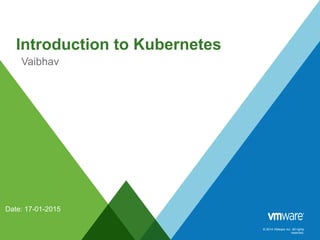
Kubernetes-Meetup
- 1. © 2014 VMware Inc. All rights reserved. Introduction to Kubernetes Date: 17-01-2015 Vaibhav
- 2. Agenda • Talk 1: Commentary on google ‘Omega’ paper • Talk 2: Introduction to Kubernetes with example • Talk 3: Kubernetes Architecture • Talk 4: Kubernetes golang code structure • Talk 5: Areas to contribute in Kubernetes • Talk 6: VMware`s contribution to Kubernetes 10
- 3. What is Kubernetes? • System for Container Cluster Management • Open Sourced by Google, launched in June 2014, Google I/O • Supports Rackspace,GCE, CoreOS, Azure, vSphere • Manages Docker containers as a default implementation but it will be supporting other linux containers soon. • Kubernetes is: • lean: lightweight, simple, accessible • portable: public, private, hybrid, multi cloud • extensible: modular, pluggable, hookable, composable • self-healing: auto-placement, auto-restart, auto-replication 11
- 5. Key Concepts Master Minion Pod : Grouping for Containers Service and Labels Container Kubernetes Node Kubelet Kubernetes Proxy API Server etcd cAdvisor 13
- 6. Master • Master maintains the State of the Kubernetes Server runtime • It is the point of entry for all the client calls to configure and manage Kubernetes components like Minions, Pods, Containers • kubelet provides commands to display pod, service and replication controller status. • All the persistent master state is stored in instance of etcd which is high availability key-store. • Master is also made up of following components API Server Scheduler Registries (Minon Registry, Pod Registry,Service Registry, Binding Registry) 14
- 7. Minion • Represents the Host / VM where containers are created as per the supporterd cloud providers. • Minion is identified with a name and a HOST IP • Key Components of a Minion; PODs Kubelet cAdvisor Proxy • cAdvisor (Container Advisor) provides container users an understanding of the resource usage and performance characteristics of their running containers. It is a separate open-source project currently integrated with Kubernetes. 15
- 9. Important Terminologies • Pod: It is the smallest scheduling unit in Kubernetes. It is a collection of Docker containers that share volumes, and don’t have port conflicts.It can be created easily by defining simple json file. • kubectl: It is a command which provides master access to Kubernetes APIs. Through it, the user can deploy, delete, list pods, among other things. • kubelet: It is a service which runs on minions. It processes the container manifests to ensure they are deployed as described by the user. 17
- 10. Pod Labels • Labels are key/value pairs that are attached to objects, such as pods. Labels can be used to organize and to select subsets of objects. • Via a label selector, the client/user can identify a set of objects. The label selector is the core grouping primitive in Kubernetes. • Example of pod label; environment=dev, environment=qa, environment=production tier=frontend, tier=backend user=vkohli,user=shrutis 18
- 11. Simple pod example with two containers
- 12. Demo
- 13. Replication Controller • Responsible for replicating a POD in case of failure. • Replication Controllers should be defined during the creation of pods. Each replicated pod will run on different minions in order to provide HA. • Replication Manager is responsible for polling PODs and maintaining the pod lifecycle. • Replication controller can be defined in the similar way as pod using the json file.
- 14. Replication Controller (contd.) • Replication controller create new pods from templates, which is currently inline to current replicationController object. • Pods created by replication controller are subsequently updated. • Lables play very important role in replication controller a loosely coupled relation is created between pods and the controller. • The replication controllers will generally carry same label as there pod to keep the mapping. 22
- 15. Basic Functionality of Kubernetes 23
- 16. Services • Abstraction of a Software Service (e.g a relational data base), consists of a proxy’s port and selector to determine the pod the service request should go to. • Elements of a Service Name Port of the proxy Labels of a Service Selector Uses LoadBalancer Container Port 24
- 17. • Kubernetes pods can come up and go down anytime, while each pod gets its own IP address those IP addresses can not be relied upon to be stable over time. • Suppose if some set of pods (let's call them backends) provides functionality to other pods (let's call it front end) it cannot be achieved if we heavily tight them each other as pods can come up and go. • So to encounter this problem we define services which provides abstraction and it offers clients an IP and port pair which, when accessed, redirects to the appropriate backends. The set of pods targeted for is determined by a label selector. 25 Services (contd.)
- 19. Guest book example • This is a simple mulit-tier web application using kubernetes and Docker. • One redis-master for storage. • 2 redis-slave replicated pods. • And also 3 front-end replicated pods running a php web application . • We will be also running some services in order to make the pods independent of each other. 27
- 20. Demo
- 21. Current Kubernetes Implementation • Fedora manual setup • Fedora ansible setup • GCE (Google Compute Engine) • vSphere • Windows Azure • AWS(Amazon Web Services) • Vagrant+Virtual box • Coreos • Many more… https://github.com/GoogleCloudPlatform/kubernetes/tree/master/docs/getting-started-guides 29